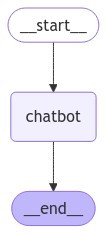昨天我們進行一個完整的生成架構圖系統,可以讓使用者輸入,並且展示架構圖,但是在實際的系統上,不一定只有生成架構圖這個選項,也可能有專注回答使用者問題的Agent、生成架構圖的Agent,各種不同的工作流需要進行控制,那麼我們可以使用LangGraph,來操控這樣的流程。
參考文章:https://langchain-ai.github.io/langgraph/tutorials/
from typing_extensions import TypedDict
from typing import Annotated
from langgraph.graph.message import add_messages
class State(TypedDict):
# Messages have the type "list". The `add_messages` function
# in the annotation defines how this state key should be updated
# (in this case, it appends messages to the list, rather than overwriting them)
messages: Annotated[list, add_messages]
graph_builder = StateGraph(State)
首先建立一個 StateGraph。 StateGraph 物件繼承State物件,在state class中會定義在這整個系統中,會使用到的各種變數,State可以說是整個變數的集合,我們等等將新增節點來表示可以呼叫的 llm 和函數,並新增邊來展示function之間轉換。
from langchain_openai import ChatOpenAI
import os
from langgraph.graph import StateGraph, START, END
os.environ["OPENAI_API_KEY"] = ""
llm = ChatOpenAI(model_name="gpt-4o")
def chatbot(state: State):
return {"messages": [llm.invoke(state["messages"])]}
# The first argument is the unique node name
# The second argument is the function or object that will be called whenever
# the node is used.
graph_builder.add_node("chatbot", chatbot)
graph_builder.add_edge(START, "chatbot")
graph_builder.add_edge("chatbot", END)
graph = graph_builder.compile()
我們定義了一個chatbot function,這個函式會去呼叫LLM,並且將此message回傳成為StateGraph的狀態變數message的內容
# draw
try:
image_data = graph.get_graph().draw_mermaid_png() # 二進制資料
with open('day28_LangGraph_workflow.png', 'wb') as f:
f.write(image_data)
except Exception as e:
print(f"意外: {e}")
pass
最後我們可以將這個系統的工作流程圖畫出來
from langchain_openai import ChatOpenAI
import os
from typing_extensions import TypedDict
from typing import Annotated
from langgraph.graph.message import add_messages
from langgraph.graph import StateGraph, START, END
class State(TypedDict):
# Messages have the type "list". The `add_messages` function
# in the annotation defines how this state key should be updated
# (in this case, it appends messages to the list, rather than overwriting them)
messages: Annotated[list, add_messages]
graph_builder = StateGraph(State)
os.environ["OPENAI_API_KEY"] = ""
llm = ChatOpenAI(model_name="gpt-4o")
def chatbot(state: State):
return {"messages": [llm.invoke(state["messages"])]}
# The first argument is the unique node name
# The second argument is the function or object that will be called whenever
# the node is used.
graph_builder.add_node("chatbot", chatbot)
graph_builder.add_edge(START, "chatbot")
graph_builder.add_edge("chatbot", END)
graph = graph_builder.compile()
# draw
try:
image_data = graph.get_graph().draw_mermaid_png() # 二進制資料
with open('day28_LangGraph_workflow.png', 'wb') as f:
f.write(image_data)
except Exception as e:
print(f"意外: {e}")
pass

